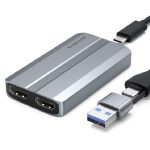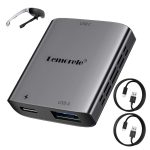In the world of home audio, the quest for pristine sound quality is paramount. When connecting your devices, the choice between HDMI and optical cables often arises. Is one truly superior to the other? Let’s embark on a journey to explore the strengths and weaknesses of each, empowering you to make an informed decision for your audio setup.
Contents
- 1 Understanding the Basics
- 2 Audio Quality: A Battle of Bandwidth
- 3 Versatility: HDMI’s Multifaceted Prowess
- 4 Ease of Use: Plug-and-Play Simplicity
- 5 Other Factors to Consider
- 6 Making the Right Choice: Tailoring to Your Needs
- 7 Bridging the Gap: Converters and Adapters
- 8 Troubleshooting: When Things Go Silent
- 9 Beyond Home Audio: HDMI and Optical in Other Applications
- 10 Conclusion: The Choice is Yours
Understanding the Basics
Before delving into the comparison, let’s establish a basic understanding of HDMI and optical cables:
-
HDMI (High-Definition Multimedia Interface): A versatile cable that transmits both audio and video signals. It’s widely used for connecting various devices, such as TVs, gaming consoles, Blu-ray players, and soundbars.
-
Optical (Toslink): A specialized cable designed exclusively for transmitting digital audio signals. It’s commonly found on devices like TVs, soundbars, and AV receivers.
Audio Quality: A Battle of Bandwidth
One of the primary considerations when choosing between HDMI and optical is audio quality.
-
HDMI’s Advantage: HDMI boasts a higher bandwidth, allowing it to transmit uncompressed, high-resolution audio formats like Dolby TrueHD and DTS-HD Master Audio. These formats deliver a richer, more immersive audio experience, particularly for movies and games.
-
Optical’s Limitations: Optical cables have a lower bandwidth, limiting their ability to transmit certain high-resolution audio formats. However, they can still handle compressed formats like Dolby Digital and DTS, which are sufficient for most everyday listening.
Versatility: HDMI’s Multifaceted Prowess
HDMI’s ability to carry both audio and video signals gives it a significant advantage in terms of versatility.
-
Single-Cable Solution: With HDMI, you only need one cable to connect your devices, simplifying your setup and reducing cable clutter.
-
Multi-Channel Audio: HDMI supports multi-channel audio formats, enabling surround sound experiences that envelop you in the action.
-
ARC (Audio Return Channel): HDMI ARC allows audio to be sent back from your TV to your soundbar or AV receiver, eliminating the need for an additional audio cable.
-
Optical’s Focus: Optical cables focus solely on audio transmission, making them a dedicated solution for pure audio applications.
Ease of Use: Plug-and-Play Simplicity
Both HDMI and optical cables are relatively easy to use, with plug-and-play functionality.
-
HDMI’s Prevalence: HDMI ports are ubiquitous on modern devices, making it a convenient and widely compatible option.
-
Optical’s Availability: While not as common as HDMI, optical ports are still found on many audio devices, offering a reliable alternative.
Other Factors to Consider
Beyond audio quality and versatility, other factors might influence your decision:
Cable Length
Both HDMI and optical cables are available in various lengths, allowing you to choose the right one for your setup.
Price
Optical cables tend to be more affordable than HDMI cables, especially for longer lengths.
Futureproofing
HDMI’s higher bandwidth and support for advanced audio formats make it a more future-proof option, ensuring compatibility with emerging technologies.

Making the Right Choice: Tailoring to Your Needs
The ideal cable for you depends on your specific requirements and priorities.
-
For the Audiophile: If you crave the ultimate audio experience and want to enjoy high-resolution audio formats, HDMI is the clear winner.
-
For the Casual Listener: If you primarily listen to music or watch TV shows with standard audio formats, optical cables offer a cost-effective and reliable solution.
-
For the Minimalist: If you prefer a clutter-free setup with fewer cables, HDMI’s ability to transmit both audio and video makes it a convenient choice.
-
For the Future-Proofer: If you want to ensure compatibility with future audio technologies, HDMI’s higher bandwidth and support for advanced formats make it a wise investment.
In the debate of HDMI vs. optical, there’s no one-size-fits-all answer. Both cables have their strengths and weaknesses, and the ideal choice depends on your individual needs and priorities.
By understanding the nuances of each cable type and considering factors like audio quality, versatility, ease of use, and futureproofing, you can make an informed decision that enhances your audio experience and brings your favorite music and movies to life.
Bridging the Gap: Converters and Adapters
What if your devices have different connection options? Fear not, converters and adapters come to the rescue.
-
HDMI to Optical Converter: This device allows you to connect an HDMI source to an optical input, ensuring compatibility even if your soundbar or AV receiver lacks an HDMI port.
-
Optical to HDMI Converter: Conversely, this converter enables you to connect an optical source to an HDMI input, useful if your TV or monitor doesn’t have an optical port.
-
HDMI Audio Extractor: This device extracts the audio signal from an HDMI input and outputs it through both HDMI and optical, providing flexibility for various setups.
While converters and adapters offer convenience, they might introduce minor signal degradation or latency. However, for most casual listening scenarios, the impact is negligible.

Troubleshooting: When Things Go Silent
If you encounter audio issues with either HDMI or optical connections, try these troubleshooting steps:
- Check Cable Connections: Ensure all cables are securely plugged into their respective ports.
- Verify Audio Settings: Check your device’s audio settings to ensure the correct output is selected (HDMI or optical).
- Update Firmware: Outdated firmware can sometimes cause compatibility issues. Check for updates for your devices.
- Try a Different Cable: A faulty cable can disrupt the audio signal. Try a different cable to see if it resolves the issue.
- Restart Devices: Sometimes, a simple restart can fix connectivity problems. Power off and then back on all connected devices.
As technology continues to evolve, newer audio connection standards are emerging. Wireless audio solutions like Bluetooth and Wi-Fi offer convenience and freedom from cables. However, for the highest audio quality and minimal latency, wired connections like HDMI and optical remain the preferred choice for critical listening experiences.
Beyond Home Audio: HDMI and Optical in Other Applications
While the primary focus has been on home audio, HDMI and optical connections extend their reach into other domains:
-
Gaming Consoles: Both HDMI and optical connections are commonly found on gaming consoles, offering options for connecting to TVs or gaming monitors. HDMI, with its ability to transmit both audio and video, is the preferred choice for most gamers due to its convenience and support for high-resolution visuals and immersive audio.
-
Computers and Laptops: HDMI ports are standard on many computers and laptops, enabling seamless connections to external monitors or projectors. Optical outputs might be available on some models, primarily for audio output to soundbars or speakers.
-
Professional Audio Equipment: In professional audio settings, both HDMI and optical find their applications. HDMI is often used for connecting audio interfaces and digital mixers to computers, while optical connections might be preferred for transmitting audio between high-end audio components like CD players and amplifiers.

Conclusion: The Choice is Yours
In the realm of digital audio connections, both HDMI and optical have their place. HDMI’s superior bandwidth and versatility make it ideal for those seeking the ultimate audio fidelity and multi-channel surround sound. Meanwhile, optical offers a cost-effective and reliable option for standard audio formats.
Ultimately, the best choice depends on your individual needs, priorities, and budget. By weighing the pros and cons of each connection type and considering your specific setup, you can make an informed decision that ensures an optimal audio experience.
So, whether you’re a dedicated audiophile or a casual listener, choose the connection that best suits your needs and immerse yourself in the world of rich, captivating sound.


